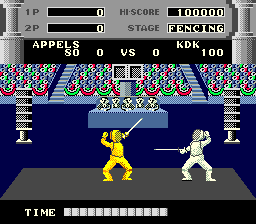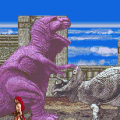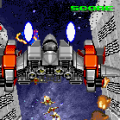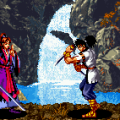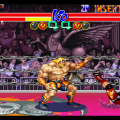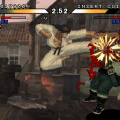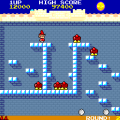
You might consider Allumer’s 1984 title, Great Swordsman, a proto fighting game since it can count itself amongst the very first entries in the one-on-one fighter genre. As the title suggests, you assume the role of a swordsman over the course of fifteen levels and varying contexts. The first three levels of the game take place in a fencing contest, followed by five in a kendo setting and finally seven more in a gladiatorial arena. Fencing requires five wins to clear a round, whereas kendo requires two. Unsurprisingly, in the arena, a single deadly sword strike will suffice.
Great Swordsman utilizes a two-way joystick for left and right movement, with three separate buttons to direct the positioning of the sword’s strike (consisting of high, medium and low). Once the attack buttons are released, you return to a neutral stance.
A bonus stage breaks up the main game, pitting the player against an archer firing arrows in successive flurries, demanding faster reflexes with each wave cleared. The stage serves as a separation between the three scenarios to diversify the gameplay, but it’s all you’ll see in terms of real variation. When clearing each scenario, you’ll receive a clear bonus, but beyond that, completing all stages will simply reset the game with a harder difficulty.
The experience boils down to striking your opponent on any part of their body, highlighting your successful blow in red along with an endearingly low-quality yell of pain. Since you can direct your blows at different levels, the goal becomes less about careless lunging and more about judging distance and anticipating enemy strikes.
It’s this command of spacing and timing required for a successful play that makes Great Swordsman a deceptively strategic experience, despite its dated appearance. You might line up what seems a guaranteed blow to the stomach, leaving yourself wide open to the AI who will punish your recklessness with a sneaky prod to your outstretched foot. In another round, the AI might aim high, propelling themselves into your well-timed stab to the stomach. In the fencing stageyou can even push opponents off the mat with relentless pressure. The game’s simplicity isn’t a measure of its depth, as clunky as it may play in retrospect.
If you can look past these stiff controls, its rudimentary presentation and jarring difficulty curve, you might appreciate this game for its merits as a fighting game milestone, a unique edition to a genre in its infancy, unbound by core conventions which had yet to even be established. Outside of this context though, it’s not aged gracefully. Even though the experience is charming in its simplicity and ambition, it doesn’t do enough to warrant frequent play, save for the title’s fondest of fans.
Consider that its karate themed competitor, Data East’s Karate Champ was released on the same year. Though strikingly similar in its visuals, it would go on to eclipse Taito’s pioneering product in both arcade popularity and commercial acclaim, most likely due to The Karate Kid’s critically lauded premier running parallel. For Allumer, it formed the foundation for their next game, Gladiator. Great Swordsman was later released on the Taito Legends pack for the PlayStation 2, and also came bundled in Taito’s arcade memories 2023 add-on card for their acclaimed tabletop arcade machine, the Egret II Mini.
